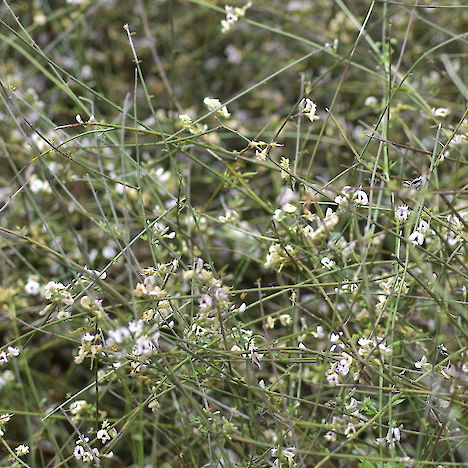Threat category:
Threatened: Nationally Vulnerable?Regions:
Marlborough, Canterbury, OtagoDistribution:
Eastern and inland South Island
Key Features
Native brooms in the genus Carmichaelia have a variety of growth habits, from small trees to low-growing shrubs, and even one climbing species. They have characteristic ‘pea flowers’ which can be very showy in some species. Many grow in areas that have potential for afforestation, and most are susceptible to browsing by stock and feral animals. As a consequence, several species are threatened.
- A scrambling or climbing broom with thin, green or bronze branches, sometimes bearing small leaves but often leafless.
- Large, purple-streaked, white flowers.
- Mottled seeds within a beaked pod.
Distribution and Habitat
- South Island east of the Main Divide from Marlborough to Otago.
- Habitat is grey scrub communities, often on toe slopes and gully sides.
Threats
- Habitat modification and loss.
- Stock browse.
- Fire.
- Inappropriate weed spraying.
Management Opportunities
- Survey for new locations.
- Mark known sites, and avoid spraying them.
- Protection of habitat.
- Translocate or reintroduce to appropriate sites.
- Ensure that forest owners are aware of potential habitats and can recognise the species.
Monitoring
- Check existing populations annually.
- Report new locations to DOC, NZPCN.
Further Information and Support
- New Zealand Plant Conservation Network (NZPCN). http://www.nzpcn.org.nz
- References:
- Dopson et al. (1999). The conservation requirements of New Zealand’s nationally threatened vascular plants. Threatened Species Occasional Publication 13. Department of Conservation, Wellington.
- Poole & Adams (1994). Trees and shrubs of New Zealand. Maanaki Whenua Press, Lincoln.
- Wilson & Galloway (1993). Small-leaved shrubs of New Zealand. Manuka Press, Christchurch.
- Wilson & Given (1989). Threatened plants of New Zealand. DSIR Publishing, Wellington.





